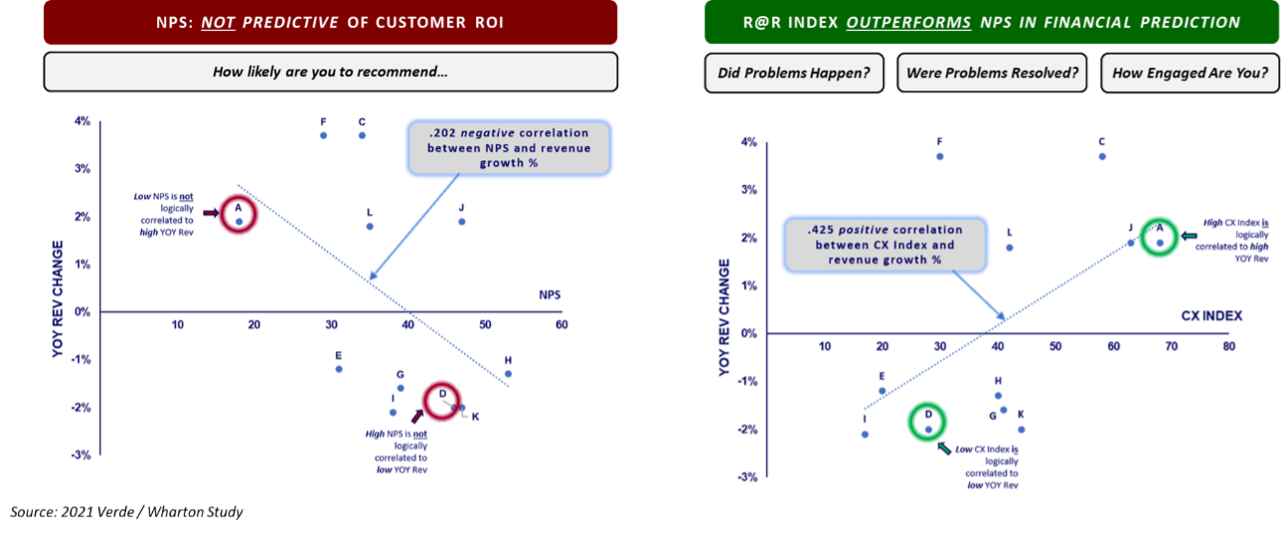In the competitive landscape of today’s business world, customer experience (CX) has emerged as a key differentiator. Customers now expect seamless interactions across all touchpoints with a brand, from the first ad, promotion, or social post they see to purchase journey and post-purchase support they receive. CX insight teams wade through mountains of data, presenting insights in the hope they drive organizational action. But to create inertia with the marketing team, data not only needs to be actionable, but linked to a financial return on investment. This is where team collaboration begins to break down.
To bridge the gap between marketing and CX organizations, it is important to understand the defining characteristics of high-performing teams. In a 2023 Forbes article, “The Hidden Secrets to High-Performing Teams,” Brent Gleeson calls out two dimensions (Relationship and Results) and their respective pillars which we believe points us in an interesting direction:
The Relationships Dimension and Associated Pillars:
- Transparency – psychological safety, radical candor, openness
- Trust – support, consistency, follow-though, autonomy
- Tone – behavioral standards, values, communication style
The Results Dimension and Associated Pillars:
- Accountability – clear expectations and roles, extreme ownership
- Alignment – alignment in strategy, priorities, and behavior
- Agility – adaptive, well-prepared to successfully navigate change
Let’s be clear, CX insights cannot solve larger relationship challenges present in an organization, but we believe a properly designed CX insight approach can improve results in support of Gleeson’s points above. This is where we find rich territory to explore. How can an improved CX insight approach support the elevation of accountability, alignment and agility between marketing and CX teams?
Increasing Accountability by Understanding What’s at Stake
There is a great debate going on between marketing and CX insight teams: Will investing in improving the customer experience based on the data presented yield improved business outcomes? Intuitively one would think the answer is clear. Of course, a better experience should drive an increase in revenues and profits. However, poorly designed insight methods and/or misleading CX beacon metrics that do not correlate to financial outcomes result in mistrust or unclear priorities.
The hard truth is that the customer experience is complex. Sifting through all the noise to find signal is a challenge and truth be told, focusing on improving one attitudinal metric is likely not going to get it done.
In a 2023 Verde Edition reader survey, we found that 66% of businesses are not consistently using CX insights to guide their decisions. Why? Our belief is that organizations are not widely using CX insights to drive business decisions due to the lack of connection to their financial performance data. This was substantiated in a separate Verde Group survey where we found that only 20% of companies link CX insights to financial results. We believe a critical first step to bridging the gap between marketing and CX teams is to define what’s at stake. By clearly articulating the financial opportunity present in the marketplace, CX and marketing teams can hold one another accountable for driving business success. Show marketing where the money is to be made and allow them to deploy the treatments and programs necessary to capture share.
Breaking Down Barriers by Aligning on What Matters
At the heart of successful collaborations between marketing and CX design teams is a customer-centric mindset. The needs and preferences of the customer should come into play in every decision they make. This means actively seeking feedback from customers, anticipating their needs, and proactively addressing any issues that arise. By putting the customer first, teams can create experiences that not only meet but exceed customer expectations, building trust and loyalty in the brand.
Here’s the rub… it’s easy to say “we’re putting the customer first,” but what does it mean? Is there an aligned perspective on what customers need and what the impact is when their experience doesn’t go as planned? Most, if not all organizations, will state that they “know their problems,” but according to Verde Group’s Pulse Database, the most frequent issues are oftentimes not the most important to brand loyalty and revenue. With 60–75% of customers experiencing at least one problem on their last interaction with your brand, it is an area rich with possibilities. By economically and strategically prioritizing the moments that matter most to business success or having a consistent “version of the truth” as it relates to experiential priorities, CX and marketing teams can align around a common set of needs, goals and initiatives.
Improving Organizational Agility by Focusing on the Critical Few
Sustaining momentum and alignment between CX and marketing teams requires a persistent set of facts be presented to ensure that actions taken based on CX insights are having the desired impact on customer behaviors. Many companies conduct regular customer satisfaction research with the belief that there’s a direct link between customer satisfaction and revenue — improving the first will drive an increase in the second. Many also rely heavily on the results of customer satisfaction surveys to build and execute action plans to drive future customer satisfaction. And so, the cycle repeats.
It turns out that these companies could be making a very costly error. Customer satisfaction is a very poor predictor of future customer behaviors. Just because a customer says they’re satisfied doesn’t mean they’ll come back to buy a company’s products or use their services. This can be a sensitive topic for some organizations that have a long history of tracking CX performance and/or have compensation and development opportunities associated with improving CX metrics. However, if these metrics are attitudinal in nature, risk exists. As covered above, many attitudinal metrics simply do not correlate to changes in financial performance and thus beg questions in collaborative team meetings and in the boardroom. This is why Verde Group is bullish on the Revenue@Risk® Index which combines three variables – the absence or presence of most damaging CX problems, the efficacy of service recovery and the degree of non-transactional engagement – to measure the holistic impact of the customer experience more accurately on business performance.
Below we compared NPS and Verde Group’s Revenue@Risk® Index to annual changes in year-over-year revenue for multiple brands:

By using a more diagnostically acute metric to measure the effectiveness of marketing programs, treatments and initiatives over time, cross-functional collaboration will be improved by a heightened sense of trust in the outcomes of CX measurement efforts.
Summary
In today’s competitive marketplace, enhancing the customer experience and maintaining trust with customers is critical for business success. With effective collaboration between marketing and CX design teams, organizations can deliver results that will make a significant impact to business outcomes. This can be achieved by:
- Holding one another accountable by defining what’s at stake. By working together to understand the relationship between CX performance and business results, CX and marketing teams can work together to achieve a common business goal.
- Aligning on the critical few issues by separating noise from signal. CX insight teams can empower marketers to focus precious resources on the moments that matter most to customer loyalty, revenue and profits.
- Improving organizational agility by using CX performance metrics that correlate to financial success. Quickly turning insights into action is a challenge, but having the right metrics in place can increase the speed and effectiveness of actions.
To establish and/or sustain a culture of cross-functional collaboration, a common set of financially grounded and actionable insights is required. It is through these efforts that CX and marketing teams can accelerate their impact and create seamless experiences that delight customers and build long-lasting relationships based on trust and loyalty.
